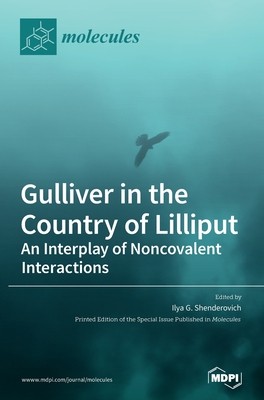
- We will send in 10–14 business days.
- Publisher: MDPI AG
- ISBN-10: 3036504303
- ISBN-13: 9783036504308
- Format: 17 x 24.4 x 1.9 cm, kieti viršeliai
- Language: English
- SAVE -10% with code: EXTRA
Gulliver in the Country of Lilliput (e-book) (used book) | bookbook.eu
Reviews
Description
Noncovalent interactions are the bridge between ideal gas abstraction and the real world. For a long time, they were covered by two terms: van der Waals interactions and hydrogen bonding. Both experimental and quantum chemical studies have contributed to our understanding of the nature of these interactions. In the last decade, great progress has been made in identifying, quantifying, and visualizing noncovalent interactions. New types of interactions have been classified-their energetic and spatial properties have been tabulated. In the past, most studies were limited to analyzing the single strongest interaction in the molecular system under consideration, which is responsible for the most important structural properties of the system. Despite this limitation, such an approach often results in satisfactory approximations of experimental data. However, this requires knowledge of the structure of the molecular system and the absence of other competing interactions. The current challenge is to go beyond this limitation. This Special Issue collects ideas on how to study the interplay of noncovalent interactions in complex molecular systems including the effects of cooperation and anti-cooperation, solvation, reaction field, steric hindrance, intermolecular dynamics, and other weak but numerous impacts on molecular conformation, chemical reactivity, and condensed matter structure.
EXTRA 10 % discount with code: EXTRA
The promotion ends in 22d.06:51:38
The discount code is valid when purchasing from 10 €. Discounts do not stack.
- Publisher: MDPI AG
- ISBN-10: 3036504303
- ISBN-13: 9783036504308
- Format: 17 x 24.4 x 1.9 cm, kieti viršeliai
- Language: English English
Noncovalent interactions are the bridge between ideal gas abstraction and the real world. For a long time, they were covered by two terms: van der Waals interactions and hydrogen bonding. Both experimental and quantum chemical studies have contributed to our understanding of the nature of these interactions. In the last decade, great progress has been made in identifying, quantifying, and visualizing noncovalent interactions. New types of interactions have been classified-their energetic and spatial properties have been tabulated. In the past, most studies were limited to analyzing the single strongest interaction in the molecular system under consideration, which is responsible for the most important structural properties of the system. Despite this limitation, such an approach often results in satisfactory approximations of experimental data. However, this requires knowledge of the structure of the molecular system and the absence of other competing interactions. The current challenge is to go beyond this limitation. This Special Issue collects ideas on how to study the interplay of noncovalent interactions in complex molecular systems including the effects of cooperation and anti-cooperation, solvation, reaction field, steric hindrance, intermolecular dynamics, and other weak but numerous impacts on molecular conformation, chemical reactivity, and condensed matter structure.


Reviews